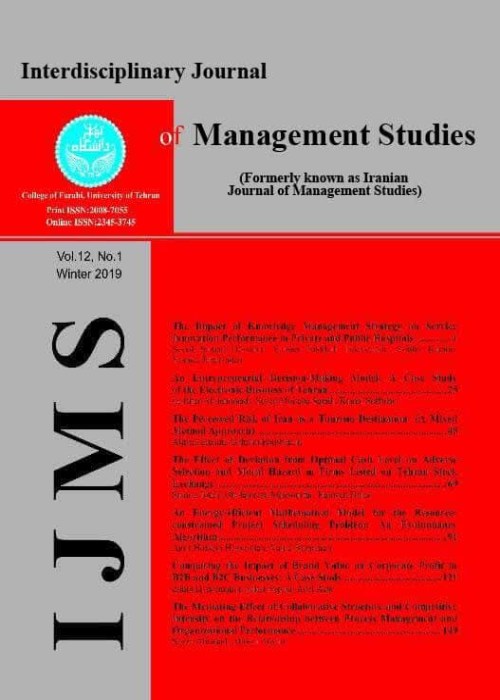Analysis and Modeling of Absenteeism Management in Iran Revenue Tax Agency Using Mixed Method
Author(s):
Article Type:
Research/Original Article (دارای رتبه معتبر)
Abstract:
Absenteeism management is considered as designing, planning, and controlling employee’s activities to increase the welfare of employees and to reduce work absence. Since the studies on absenteeism management are limited, the goal of this paper is to develop a model for absenteeism management in Iran Revenue Tax Agency (IRTA). In this study, the management of employee absenteeism is analyzed qualitatively and quantitatively (Mixed Method). In the qualitative part of this study, a non-probability method and a dependent heterogeneous method are used for collecting data. Also 18 in-depth and semi-structured interviews are performed with organizational experts and employees who have been frequently absent from their work in IRTA. Furthermore, the collected data from the qualitative part is analyzed using MAXQDA software. In the quantitative section, the absenteeism management model is presented based on Grounded Theory (GT) assumptions and in the quantitative part, 314 questionnaires are collected by using the random sampling method. In addition, the data were analyzed by Exploratory Factor Analysis (EFA) and Confirmatory Factor Analysis (CFA) methods by using SPSS and Amos software, respectively. The GT model of employee absenteeism management is confirmed in the quantitative section. The results of this model contain five parts of the GT method that are: 1) Casual conditions such as negative learning and dysfunctional control, career management problems, and lack of well-being, 2) Interfering factors: unexpected incidents, demographic factors, staff history, and personal values, 3) Contextual factors that are: cultural and biological issues, external institutions, political interventions, and partisanship of legal capacities, 4) Strategies for reducing the employee absenteeism such as considering employee expectations from management, creating a culture of calmness, clarity, support, and monitoring people in all levels and career stages and 5) Consequences such as satisfaction, trust, productivity, work-family balance, and benefits for the organization, improving job attitudes.
Keywords:
Language:
English
Published:
Iranian Journal of Management Studies, Volume:15 Issue: 3, Summer 2022
Pages:
595 to 611
magiran.com/p2443111
دانلود و مطالعه متن این مقاله با یکی از روشهای زیر امکان پذیر است:
اشتراک شخصی
با عضویت و پرداخت آنلاین حق اشتراک یکساله به مبلغ 1,390,000ريال میتوانید 70 عنوان مطلب دانلود کنید!
اشتراک سازمانی
به کتابخانه دانشگاه یا محل کار خود پیشنهاد کنید تا اشتراک سازمانی این پایگاه را برای دسترسی نامحدود همه کاربران به متن مطالب تهیه نمایند!
توجه!
- حق عضویت دریافتی صرف حمایت از نشریات عضو و نگهداری، تکمیل و توسعه مگیران میشود.
- پرداخت حق اشتراک و دانلود مقالات اجازه بازنشر آن در سایر رسانههای چاپی و دیجیتال را به کاربر نمیدهد.
In order to view content subscription is required
Personal subscription
Subscribe magiran.com for 70 € euros via PayPal and download 70 articles during a year.
Organization subscription
Please contact us to subscribe your university or library for unlimited access!



